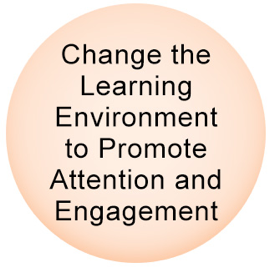How can school personnel intensify and individualize instruction?
Page 5: Change the Learning Environment
 Another quantitative method for adapting instruction is to change the learning environment. This method, also easy to implement, changes the way the student receives intensive intervention and increases the amount of instructional time a student receives. Teachers can change the learning environment by:
Another quantitative method for adapting instruction is to change the learning environment. This method, also easy to implement, changes the way the student receives intensive intervention and increases the amount of instructional time a student receives. Teachers can change the learning environment by:
- Reducing group size (e.g., from six students to four)
- Grouping students with similar abilities (i.e., homogenous grouping) rather than grouping students of varying abilities (i.e., heterogeneous grouping)
- Reducing classroom distractions like noise, and otherwise promoting academic engagement
Research Shows
When providing intensive intervention to middle and high school students, providers must reduce the group size to achieve greater intensity.
(Scammacca, Roberts, Vaughn, Edmonds, Wexler, Reutebuch, & Torgensen, 2007)
Benefits of Changing the Learning Environment

The adaptations listed above indirectly increase the amount of instructional time a student receives. When teachers reduce the group size or provide the intervention in homogenous groups, students spend more time engaged in instruction that meets their specific needs. For example, Natalia receives 20 minutes of secondary intervention in reading with four other students three times per week. School personnel decide to adapt her instruction by reducing the intervention group size to three and by placing her in a group with students who also struggle with decoding. By making these types of adaptations, teachers can also:
- Interact more with each student
- Provide more opportunities for students to practice and receive corrective feedback
- Match instruction to the students’ needs
- More closely monitor the students
Additionally, by reducing distractions teachers can reduce off-task behavior and increase the amount of time that the students are actively engaged in instruction.
Considerations for Changing the Learning Environment
If the student is not responding adequately to instruction in the current learning environment, teachers can consider the following questions to help guide their decision.
- How many students are in the group?
- Is the group heterogeneous or homogenous? In other words, are the students grouped according to similar abilities (e.g., they struggle with decoding) rather than by broad abilities (e.g., they struggle with reading)?
- How long can the student remain engaged and on task?
- Does the student seem to be distracted? If so, by what?
For Your Information
- Although there are no specific guidelines for group size, elementary students might benefit from a small group with no more than four students.
- Little difference has been found between the instructional outcomes of students receiving one-on-one instruction and those receiving instruction in small groups of three.